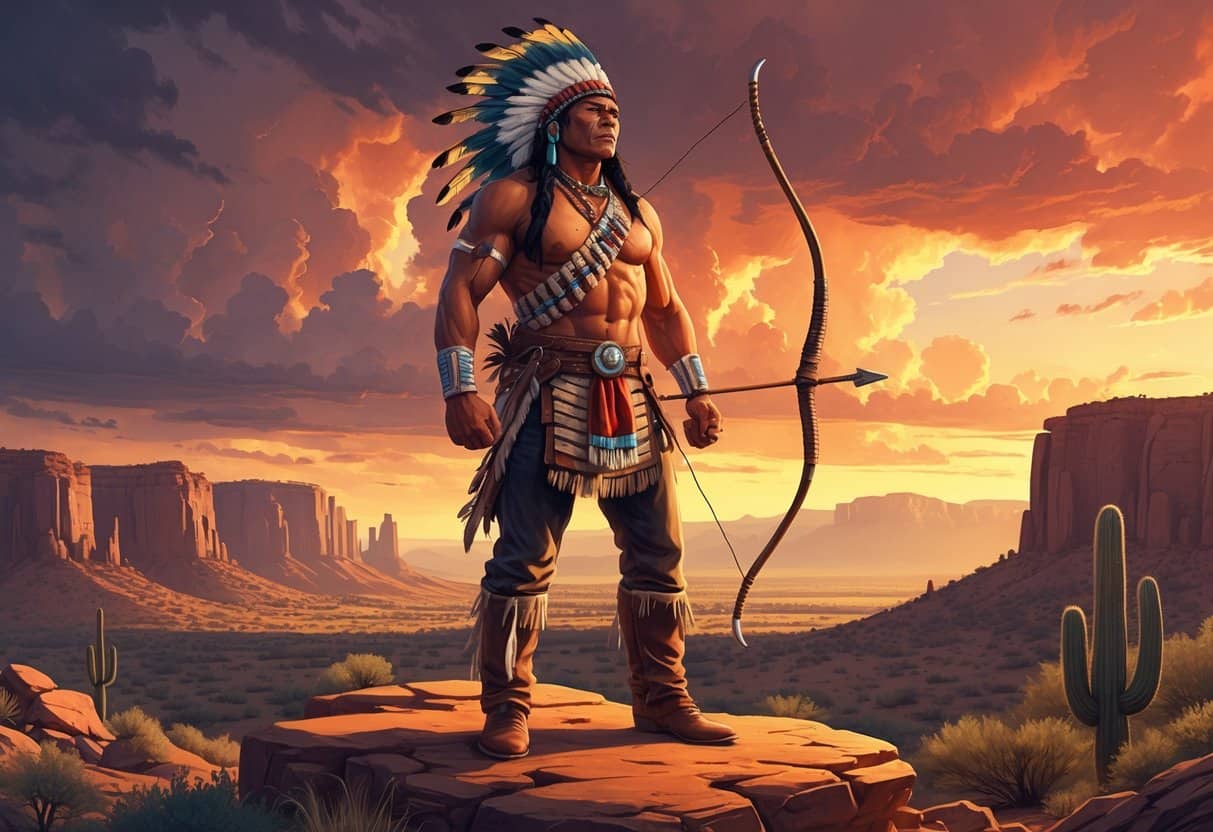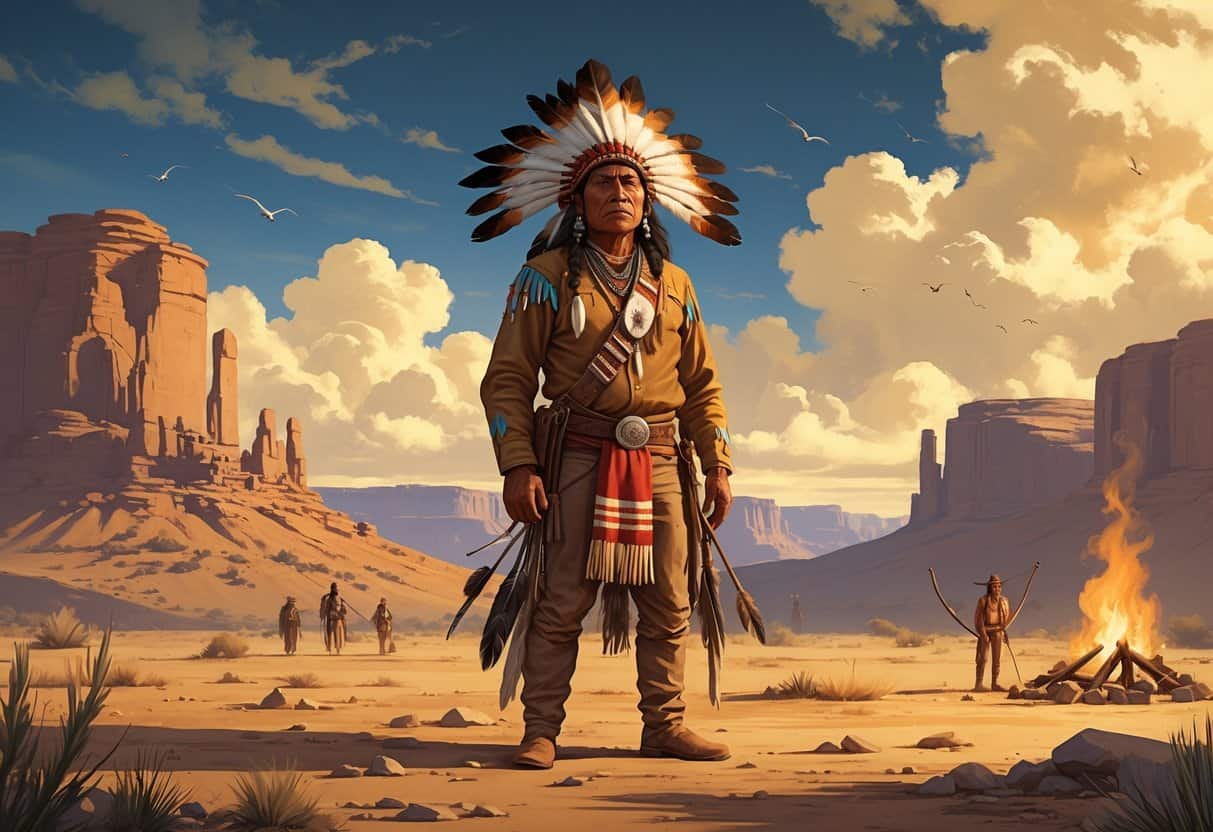Geronimo stands out as one of the most well-known figures in Native American history, famous for his fearless resistance against U.S. forces.
He became a symbol of defiance by leading his Apache people in battles to protect their land and way of life, refusing to surrender even when things looked bleak.
His actions showed a level of courage and resilience that’s honestly hard not to admire, especially considering the challenges Native Americans faced back then.

Geronimo’s life and battles helped shape his reputation as a leader who never stopped fighting for his people.
His story has been told in books and media, helping more folks understand the struggles Native Americans experienced.
By digging into Geronimo’s life, you get a window into the broader history and spirit of resistance woven through Native American culture.
Key Takeways
- Geronimo stood as a lasting figure of Native American courage and resistance.
- His leadership helped protect Apache land and culture during tough times.
- His story influences how Native American history is taught and remembered.
Geronimo’s Life and Historical Context

You’ll see how Geronimo’s early life, rise to leadership, and the challenges during the Apache Wars shaped him.
His story also includes years of imprisonment and his impact on American history—whether people like to admit it or not.
Early Years and Ancestry
Geronimo was born in 1829 and named Goyahkla, which means “One Who Yawns.”
He belonged to the Bedonkohe band of the Chiricahua Apache Indians.
His early years were rooted in his tribe’s traditions and a deep connection to their land.
Geronimo’s family faced violence from Mexican soldiers, and this loss pushed him toward becoming a fighter.
His people lived in areas that are now Arizona and New Mexico.
Those first experiences with conflict gave him a strong sense of duty to protect his people and their way of life.
Rise as a War Chief
Geronimo became a respected war chief among the Apache Indians.
Known for his bravery, he led raids and fought against both Mexican and later American forces.
He followed leaders like Cochise, Victorio, and Mangas Colorado, who also resisted outside control.
His reputation grew as he showed skill in tactics and survival.
Geronimo earned respect for defending the Indeh (Apache) culture in tough times.
His ability to lead through rough terrain and harsh conditions made him a key figure.
The Apache Wars and American Expansion
During the Apache Wars, Geronimo fought to keep his people free from American and Mexican control.
These wars happened during American history’s westward expansion, which pushed Native Americans off their lands.
The U.S. government tried to move Native Americans onto the San Carlos and Fort Apache reservations.
Geronimo and his followers resisted these efforts fiercely.
The government even used Apache Scouts like S. M. Barrett to track down resisting bands.
Geronimo’s group escaped capture over and over, which turned him into a symbol of defiance.
His actions made him a target but also a symbol for Native American rights and freedom.
Imprisonment and Later Years
After years of fighting, Geronimo surrendered in 1886.
He spent many years imprisoned far from home—first in Florida, then Alabama, and later in Oklahoma.
Despite captivity, Geronimo stayed a symbol of resilience.
He lived on the Fort Sill reservation, sharing his stories and working as a scout.
His later life was marked by attempts to adapt while keeping his identity.
Geronimo died in 1909, but his story still stands as a powerful example of courage and resistance.
| Period | Location | Key Events |
|---|---|---|
| Early Life | Arizona/New Mexico | Family losses, tribal roots |
| Rise to Chief | Apache lands | Leadership, battles |
| Apache Wars | Southwest US/Mexico | Fighting reservations, escapes |
| Imprisonment | Florida, Alabama, Oklahoma | Captivity, later life |
Symbolism and Legacy of Defiance
Geronimo stands as a symbol of resistance, complex identity, and ongoing influence among Native Americans.
His story touches on fights against American expansion, later misuse of his image, and the inspiration he provides to modern Native activists.
Resistance Against American Expansion
Geronimo led his Apache warriors in fierce resistance against the U.S. military and settlers moving into their lands.
His defiance was a direct challenge to American expansion in the 1800s.
His fight was about protecting his people’s way of life, land, and freedom.
Many people at the time called him savage, trying to justify the slow takeover of Native lands.
To Native Americans, though, Geronimo meant bravery and the fight to keep culture alive.
He refused to accept the loss of his homeland, making him a lasting symbol of survival and courage.
Cultural Appropriation and Stereotypes
Geronimo’s image is often misunderstood or just plain distorted in popular culture.
His story has been used to justify stereotypes of Native Americans as savage or wild, which totally misses the real history.
In classrooms and media, Geronimo sometimes gets reduced to a symbol of violent resistance without any real explanation.
The use of his name for sports teams or products strips away the true meaning of his legacy and ignores Native voices.
This misuse can undermine the respect due to him and Native cultures.
Impact on Native Activism and Identity
Geronimo remains a powerful figure for Native activists today.
His spirit echoes in movements fighting for Native rights and cultural recognition.
Groups use his legacy to resist ongoing challenges like land rights, cultural preservation, and legal injustice.
His story helps shape Native American identity in ways that connect past struggles to current activism.
Events like Powwow Highway honor this resistance and keep Native heritage alive.
Learning about Geronimo’s life encourages respect for Native resilience and the continued fight for justice.
Representation in Literature, Media, and Education
Geronimo’s life and legacy have been shared through all sorts of media, shaping how people see his role in history.
His story appears in biographies, movies, and lessons, each offering a different take on his defiance and impact.
Geronimo’s Story of His Life and Biography
Geronimo’s story is often told through books and graphic novels, which can help you see his life as a journey of resistance.
One well-known graphic novel about his life was created by Greg Ruth.
It uses clear, visual storytelling that works for readers who don’t love long texts.
Biographies focus on key moments like his leadership in defending Apache lands and his resistance to U.S. forces.
These works try to balance facts with respect for Geronimo’s culture.
You’ll find many of these stories in the public domain or in newer books recognized by the American Library Association, like those with the Alex Award for young adults.
Depictions in Media and Popular Culture
Geronimo has appeared in films, TV shows, and documentaries, which all shape your image of him.
PBS’s series We Shall Remain offers a detailed look at his life.
It tries to correct older, inaccurate portrayals that painted him only as a violent figure.
Movies like Smoke Signals by Sherman Alexie and actors like Ethan Hawke have brought Native American stories to wider audiences.
These works focus on Native perspectives and challenge stereotypes, helping you see Geronimo as a symbol of courage, not just a historical rebel.
Use in Curriculum and Libraries
Educators and librarians use Geronimo’s story to teach about Native American history and resistance.
Books about him often show up in school libraries and reading lists, especially for reluctant readers who might benefit from graphic novels and more accessible language.
Organizations like the American Library Association promote balanced materials to improve understanding of Native Americans.
Teachers rely on carefully selected texts to avoid stereotypes, helping students see Geronimo’s complexity and the broader context of Native American struggles.
Historical Parallels and Broader Impacts
Geronimo’s story echoes the struggles of other Native leaders who resisted U.S. and settler expansion.
His military actions and defiance shaped how the U.S. military and society viewed Native American resistance as a whole.
Other Native Leaders and Movements
Geronimo’s resistance shows up in the stories of Chief Joseph, Sitting Bull, Tecumseh, and Pontiac.
Each led efforts to protect their people and land from settlers and the U.S. government.
Chief Joseph tried to lead the Nez Perce tribe to safety but was forced into surrender.
Sitting Bull united Lakota tribes against U.S. forces in the Battle of Little Bighorn.
Tecumseh built a confederacy to stop American expansion in the early 1800s.
Pontiac led Native uprisings against British forces after the French and Indian War.
These leaders, like Geronimo, used raids and guerrilla tactics to fight better-armed opponents.
Quanah Parker, a later leader, transitioned from war to negotiation, showing different survival choices after conflict.
Altogether, these figures show a timeline of Native attempts to maintain sovereignty during and after the frontier’s violent expansion.
Military and Social Legacy
Your understanding of U.S. military history really shifts when you bring in figures like Geronimo. His “war trail” raids pushed the U.S. Army to rethink their tactics.
He became this symbol of Native defiance, yet ended up as a prisoner of war. That twist shows how resistance could lead to capture instead of victory.
Geronimo’s story nudged the military to change how they dealt with Native uprisings, especially around the Civil War era. The U.S. expanded its frontier campaigns and started tweaking policies for dealing with tribes.
You can spot traces of this in the way later Indian Wars and reservations were handled. It’s not exactly a proud chapter, but it’s there.
On the social side, Geronimo shaped how Native American identity was viewed. His courage got woven into Native pride.
At the same time, settlers and the government leaned into framing Native Americans as obstacles. Geronimo’s legacy still pops up in conversations about sovereignty and cultural survival—he’s kind of unavoidable in that sense.